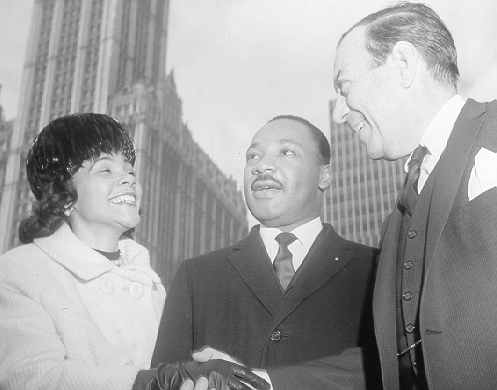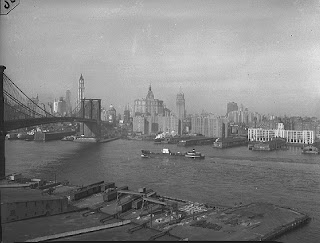About:
Established in 1982 at LaGuardia Community College/ CUNY with a mission to collect, preserve, and make available primary materials documenting the social and political history of New York City. We hold nearly 5,000 cubic feet of archival records and 3,200 reels of microfilm with almost 100,000 photographs and 2,000,000 documents available on our website.
Monday, January 30, 2012
This Date in History App for Android and Apple
I am proud to announce the release of the CUNY/New York Times in College This Date in History App developed by the LaGuardia and Wagner Archives for both Apple and Android platforms. Using the milestones and photos from this year's and earlier calendars/websites, the Archives has created an app which delivers daily fascinating events in U.S. history for every day of the year. I hope you'll download it and let us know what you think.
Friday, January 27, 2012
Marijuana Legalization Arguments Similar to La Guardia's Arguments Against Prohibition
Steven A. Levine
Coordinator for Educational Programs
Ninety three years ago this month the 18th Amendment to the U.S. Constitution was ratified, banning the "manufacture, sale, or transportation of intoxicating liquors." Congressman Fiorello H. La Guardia was a major opponent of prohibition. In the 1926 photo below you can see him mixing "near beer" with malt tonic to create 2% beer to demonstrate how easily Prohibition could be flouted. In his article "Prohibition: A National Farce" (March 1927 "A Smokers Companion"), La Guardia argued that Prohibition was impossible to enforce, led to criminality, and cost the government hundreds of millions of dollars in tax revenue. In "Marijuana Push in Colorado Likens It to Alcohol," The New York Times reports similar arguments being made by proponents of marijuana legalization, "Banning or improperly regulating a substance that large numbers of people will use anyway failed in the 1920s with alcohol - with the spread of speakeasies and corruption during Prohibition - and is failing now with marijuana, they say."
Fiorello La Guardia pouring beer at his congressional office, June 1926.
The La Guardia and Wagner Archives explores these issues in our "Unforgiving Economy" calendar/website in a month called "The Underground Economy," and developed a lesson in our Women's Leadership Curriculum on temperance and prohibition, called 19th Century Reformers Ida Wells-Barnett and Frances E. Willard.
Below are some other interesting links related to that theme:
Friday, January 20, 2012
The Unforgiving Economy 2012 Calendar and Website
Steven A. Levine
Coordinator for Educational Programs
Coordinator for Educational Programs
The Archives is proud to announce the release of "The Unforgiving Economy" website, based on our 2012 calendar. Available in both English and Spanish, it is an economic history of the United States with beautiful and striking photos and artwork. Please check it out and let us know what you think.
Thursday, January 12, 2012
Civil Rights in New York City: In Honor of Dr. Martin Luther King, Jr.
Steven A. Levine
Coordinator for Educational Programs
Coordinator for Educational Programs

Dr. Martin Luther King and Coretta Scott are welcomed by Robert F. Wagner at City Hall upon King's return to the U.S. after receiving the Nobel Peace Prize, December 18, 1964.
Dear Friends and Colleagues,
In the spring of 1963, Birmingham, Alabama was the focal point of the civil rights movement. Mass demonstrations, sit-ins and protests led to the arrest of hundreds, including Dr. Martin Luther King, Jr., by the brutal police force of Commissioner of Public Safety Eugene "Bull" Connor.
With the nation's attention focused on Birmingham, New York's Fur and Leather and Machine Workers Union organized a Rally for Equality on May 28th, 1963 to support the civil rights struggles in the South. Scheduled to speak at the event was Mayor Robert F. Wagner. What was striking about his speech was not Wagner's support for the freedom struggle in the South, but for its focus on civil rights in New York City. He declared "If all we are going to do for the freedom fighters of the South is to express our sympathy for them, that might be helpful, but it wouldn't be enough. It might even be considered a little hypocritical?"
He used the rally to recommit his administration to fighting discrimination in New York City, issuing an executive memorandum directing all city agencies and departments "to review and re-assess all their present programs and activities pertaining to equal rights and opportunities for all" with the goal of expanding them or launching new ones. Wagner was sincere, but he was also responding to a growing civil rights movement organizing to desegregate housing and public schools, end discrimination in employment, and empower New York's growing African-American and Latino populations.
Wagner's speech was a harbinger for the increasing polarization of New York City on racial issues. Even as he gave his speech, his office had created a folder for "hate mail" from people opposed to his civil rights initiatives and his support for the movement in the South. (Sample) Simultaneously, the slow pace of change was leading to greater anger and impatience in the African-American community. A year later, the NYPD would be putting down an uprising/riot in the streets of Harlem and Bedford-Stuyvesant, after an off-duty police officer shot and killed an unarmed African-American high school student.
Friday, January 6, 2012
PUBLIC HOUSING: New York Transformed 1939-1967 Web Exhibit
Smith Houses under construction -- the tall grayish buildings to the
right of the Brooklyn Bridge, January 19, 1950. ID# 02.003.11282
I hope you'll check out "PUBLIC HOUSING: New York Transformed 1939-1967" on our website at http://www.laguardiawagnerarchive.lagcc.cuny.edu/NYCHA_PHOTO_GALLERY.aspx
The exhibit uses the La Guardia and Wagner Archives unparalleled collection of New York City Housing Authority (NYCHA) photo negatives with commentary by Professor Joel Schwartz to document the history of public housing and how it changed the fabric of New York City. The photos are not only of public housing, but of the buildings, people and street life of the neighborhoods before public housing was built.
It is now a highlight on the Archives' NYCHA web page http://www.laguardiawagnerarchive.lagcc.cuny.edu/COLLECTIONS.aspx?ViwType=1&ColID=2, where you can see more photos of public housing and New York City.
Please leave a comment if you would like to know more about the NYCHA Collection or the history of public housing in New York City history.
Subscribe to:
Posts (Atom)





